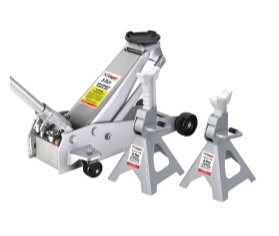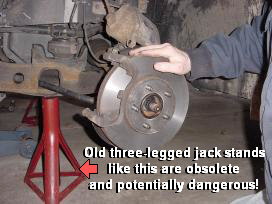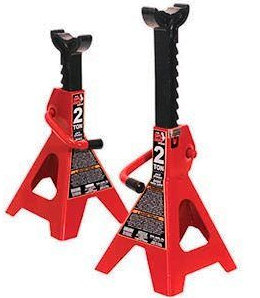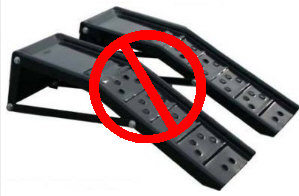
Home, Auto Repair Library, Auto Parts, Accessories, Tools, Manuals & Books, Car BLOG, Links



One tool every do-it-yourselfer or weekend mechanic needs is a good reliable car jack (and at least one or more pairs of support stands). A car jack is an indispensable tool for changing oil, replacing a starter, installing a new muffler, exhaust pipes, shock absorbers or struts, doing any type of steering or suspension work, replacing a transmission or a clutch, or rotating tires.
The original equipment bumper jack or scissor jack found in the trunk of most vehicles is barely adequate for changing a flat tire, let along doing any type of repair work - and totally worthless for rotating tires or raising the front end, rear end or both ends of your vehicle off the ground. What you need is a strong, reliable floor jack.
Hydraulic floor jacks are available in a wide range of styles and capacity ratings. Most have wheels or rollers for positioning the jack under your vehicle, and a long handle for pumping up the jack. The cheapest jacks usually have the lightest capacity ratings (typically 1-1/2 tons or 3,000 lbs.), and the handle has to be removed from the jack pump to twist a separate pressure release valve to lower the jack. The better floor jacks have a higher capacity rating (2 tons and up), and the handle serves both purposes: you pump it to raise the jack, and twist it to open the pressure release valve.


Look for heavy steel construction if you want long term durability. Or, you can buy an aluminum jack if portability and light weight are important, and you are willing to pay more for the aluminum construction. The difference in weight can be considerable, but so can the difference in cost.
Watch out for poorly made aluminum racing jacks. Made-in-China aluminum racing jacks that sell in the $50 to $80 have flooded the market in recent years. They seem like a great bargain, but have had reliability issues with the hydraulics in the pump. Fluid leaks both internal and external can make these jacks unsafe and unreliable. For more information about these jacks, Click Here..
Raising a vehicle involves a certain amount of risk. If done correctly, it poses no danger to you or anyone else. But if done incorrectly, it could cost you your life!
SAFETY RULE #1: NEVER trust a jack, and NEVER crawl under a vehicle supported by a jack alone. Always position a pair of sturdy jack stands under the frame, subframe, axle or control arm(s) to prevent the vehicle from falling on you. Cinder blocks, wooden boards, logs, old wheels, metal cans or anything else that may be laying around are NOT jack stands and should NEVER be used to prop up a vehicle.

SAFETY RULE #2:Always place the transmission in gear or Park, set the parking brake and/or block the wheels with a brick, chunk of 4x4 or a safety chock to prevent the vehicle from moving or rolling when you are jacking it up.
If you are raising one or both FRONT wheels off the ground on a Rear-Wheel Drive (RWD) or Four-Wheel_drive (4WD) car or truck, the parking brake and/or transmission should keep the vehicle from rolling. But if you are raising the REAR wheels off the ground, you must block the front wheels to prevent the vehicle from moving.
If you are raising one or both FRONT wheels off the ground on a Front-Wheel Drive (FWD) car or minivan, the parking brake should hold the rear wheels. You should still block the rear wheels because the parking brake may not hold tight enough to prevent the vehicle from moving. If you are raising the REAR wheels on a FWD car or minivan off the ground, the transmission should hold the front wheels. Blocking the front wheels is still a good idea for an extra margin of safety.
If you are raising all FOUR wheels off the ground on any type of vehicle, block the wheels on the front, then raise the rear wheels off the ground. Position safety stands under the rear axle, control arms or frame to support the rear of the vehicle, then lower the jack so the weight is fully supported by the stands. Make sure the vehicle is stable before raising and supporting the front wheels.
SAFETY RULE #3:Always work on a relatively FLAT surface. Don't jack up a vehicle if it is sitting on an incline or a hill. A slope of only a few inches can be enough to cause a vehicle to roll when it is raised off the ground.
SAFETY RULE #4:If you will be working under your vehicle, tell someone so they can check on you periodically. Or, have a cell phone in your pocket so you can call someone should something go wrong and you find yourself trapped or pinned under your vehicle. If you follow the first three safety rules, this rule should not be necessary.
SAFETY RULE #5: When raising a vehicle, position your floor jack under the lift points indicated in your owners manual. On most late model vehicles, the factory lift points for the factory scissor jack are flattened areas along the rocker arm pinch welds on both sides of the car. But with a floor jack, you want something more substantial to support the weight of the vehicle. Position the jack under an axle, control arm, subframe or frame. Do not place it under any sheetmetal, the engine oil pan, steering linkage, radiator support or other such components. Make sure there are no fuel lines, brake lines or vent hoses between the jack and vehicle when you raise it.
SAFETY RULE #6: Go easy on the leverage when yanking, pulling, prying, pushing or jerking on things when working under your vehicle. You might shake it or tip it off its jack stands! The best advice here is to use a pair of jack stands AND a jack to support one or both ends of the vehicle. If a support stand slips, hopefully the jack will stop the vehicle from falling any further.

For years, the most common type of aftermarket "safety" stands had three legs made of thin gauge steel. The legs had no base but were supported by thin brackets spot welded between the legs. The center portion of the stand was cylindrical, and fitted with a tubular support that could be raised and lowered by removing and inserting a steel pin through the holes in the tube. These stands are no longer made, but can still be found in garage sales and resale shops. What makes them dangerous is their flimsy construction. The spot welds can pull apart without warning, allowing the stand to collapse. The pins can also slip if not properly inserted all the way through the center tube.
Most of the jack stands that are sold today have four sturdy legs, with an adjustable cast iron ratchet bar in the center that can be raised or lowered as needed with a lever. The teeth on the ratchet mechanism lock the support bar in place so it can't drop. These are a good design, but make sure the weight capacity of the jack stands exceeds that of your vehicle.

Position the safety stands under the factory lift points along the sides of your vehicle, or under an axle, control arm, subframe or frame. Raise or lower the stands as needed to achieve the desired under car clearance, then lower the jack until the weight of the vehicle is resting on the stands. Leave the jack in place as a backup support.
One company makes a product called "JackPoint" jack stands. These stands are designed to work with the factory life points along the side of a car. A small circular adapter is positioned on top of a floor jack. After the vehicle is raised, the JackPoint stands are slid into place to support the car when the jack is lowered.
Those stamped steel or heavy plastic drive-on car ramps seem like a simple tool for raising a vehicle. Just position a pair of ramps in front or behind your vehicle and drive up on them. Yeah, right. The first thing you'll discover is that the air dam on the front of many cars is too low to clear the ramps. You'll either push the ramps ahead of your car or damage or break the air dam while trying to drive on the ramps.

Even if you have enough clearance under the front (or rear) of your vehicle to clear the ramp, the ramps usually don't stay put when you try to drive up on them. The ramps tend to slid as soon the wheels start to push against them. The tires can also spin and slip as you attempt to drive up the ramp.
Then there's the problem of knowing when to stop. Go to far and you'll drive right off the ramp. The ramps do not have stops on them to prevent you from overshooting the ends of the ramps, and there's no way to lock or hold the tires in place if you were successful in driving onto the ramps. This can be especially dangerous because you vehicle may roll back off the ramp unexpectedly.
Case in point: A do-it-yourselfer wanted to replace the exhaust system on his car. He needed a lot of clearance underneath so he planned to raise all four wheels off the ground, using ramps for the front wheels and a jack and safety stands for the rear wheels. He got the front wheels up on a pair of ramps, then attempted to raise the rear wheels off the ground with a floor jack positioned under the rear axle differential. What he failed to realize is that the arm on a floor jack follows an arc as it raises up. with the jack positioned under the rear axle, the jack pulled the car backwards a couple of inches as it raised it up - which was just enough to roll the front tires off the flat portion of the ramps and onto the slanted portion of the ramps. The car suddenly rolled backwards down the ramps. Our hapless friend, still holding onto the jack handle, found himself being pushed backwards by the vehicle as it rolled off the ramps. Fortunately, he was able to jump out of the way. But the car rolled all the way down the driveway and into the street before it finally stopped. Had our friend not been able to jump out of the way, he could have been severely injured or killed. That's why we do NOT recommend using car ramps.
 Related Articles:
Related Articles: